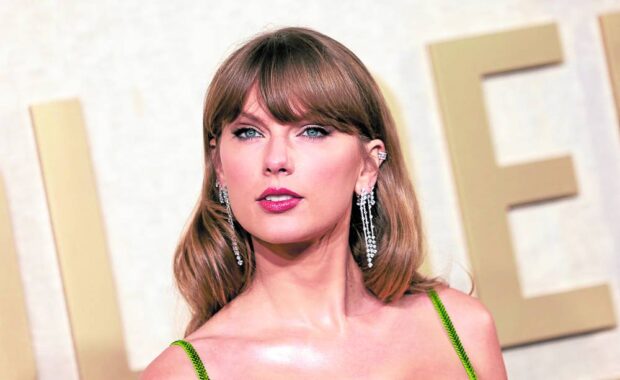
Taylor Swift (Agence France-Presse)
MANILA, Philippines — Swifties in the Philippines — skipped over in the world tour of American superstar Taylor Swift — may soon be flocking to lecture halls rather than concert arenas to know their idol more.
One such academic venue is the College of Mass Communication (CMC) at the University of the Philippines (UP) in Diliman, which has introduced a course this semester exploring Swift’s impact on pop culture.
While students in this class will certainly listen to her songs and watch her interviews, they will not spend the semester deconstructing the lyrics of “All Too Well” or figuring out who “Getaway Car” was written for.
Instead, the class will focus on the Swift phenomenon — and the Filipinos’ relationship with celebrities and global products in general.
“It’s a very broad field,” said Cherrie Brillon, the associate professor who is handling the class.
“But within that field, you can talk of the celebrity as a spectacle, you can talk of the celebrity as a gender construction, in a parasocial context or as an empowering figure or disempowering figure,” she told the Inquirer.
“But most of all, we discuss the possibility of a celebrity to embody the aspiration of a group, society, or a nation.” ‘Deep-rooted’
The course, which will be taught as an elective under CMC’s Department of Broadcast Communication, can be considered another measure of the singer’s popularity.
The Philippines ranks fifth among the top countries streaming Swift’s music, but for Brillon, herself a Swiftie, it is still the world’s biggest “Taylor Nation.”
“Most of the time, we don’t realize that our relationship with celebrities is really deep-rooted,” she said. “We saw it in the way that our worlds stopped when ‘KathNiel’ (the love team of Daniel Padilla and Kathryn Bernardo) broke up, and [in] the way that celebrity status is intertwined with politics.”
“However, we’re using Taylor Swift and who she is [for] media studies with a focus on celebrity, so we cannot avoid the biggest celebrity, the biggest pop star in the world,” Brillon added.
Swift’s star particularly shone during the pandemic, especially after she rereleased her old albums, making her a central, coming-of-age heroine whom millennials and Gen Zers found so relatable.
Her current tour, “Eras,” became the highest-grossing show in pop history, expanding her influence beyond the music industry to the point that Time Magazine named her Person of the Year in 2023.
READ: WATCH: Filipino ‘Swiftie’ travels 8,400 miles to see Taylor Swift | INQStories
READ: WATCH: UP’s ’student emeritus’ finally graduates after 18-year delay | INQStories
‘Fan-driven’
When Swift’s tour skipped the country, Filipino fans filled the void with “Taylor Sheesh,” a drag queen who performs her setlist in mall shows.
But what got Brillon thinking about Swift’s impact was something she saw during the 2022 elections, when Swifties — together with other fandoms — mobilized to help the campaign of then-presidential candidate Leni Robredo.
It was the “first time … that I noticed that the way the people were doing political campaigns was very much fan-oriented and fan-driven,” Brillon said.
“From something that is purely entertainment, they have fully crossed over to politics. That’s a very interesting phenomenon of how a celebrity is able to mobilize their power and inspire,” she added.
In the United States, the Swift success story has become an academic subject at Harvard, Stanford, and New York University (where she was conferred an honorary degree in 2022).
Currently fine-tuning the syllabus, Brillon is careful not to make the UP course a mere duplicate of the earlier US versions.
A course centering on a single contemporary celebrity is a first in UP, but pop culture studies are nothing new in the Philippine academe. Academic forums and research projects, for example, have raised the level of discourse on the magnetism of K-pop, while literature classes have delved into The Beatles ethos.
Her class being focused on media studies, Brillon says it is worth exploring Swift’s rise to stardom and how Filipinos appropriated her image.
The students, for example, would also be encouraged to look into the “controversial” aspects of the singer’s persona—her brand of “white feminism,” her take on political issues.
But ultimately, Brillon hopes to see students enjoying the course.
“As a fan who is deeply familiar with Swiftie lore, [and speaking from] the more honest part of me, I offered this course because gusto ko makipagmarehan [I just want to know the latest news about our idol],” she said, breaking into a giggle.
Brillon said her introduction to Swift was the singer’s fourth album “Red,” but that her “guilty pleasure” would always be 2019’s “Lover” — her go-to album “if I want to feel happy.”
Careful not to reduce the Swift studies into generalizations and fawning praises, she said the American singer may be considered the “embodiment” of the aspirations of Filipino millennials and Gen Z youths, who have been “raised on the idea that they could be anything … being situated here but still open to the ideas of the world.”

